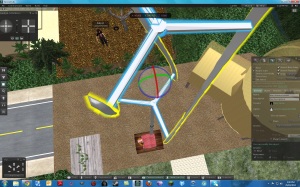Constructivism is an approach to instruction that over the last decade has been implemented and considered by many theorists and practitioners. It is however only one of many learning theories and it is hotly debated as to it’s usefulness in all situations. I invite you to consider your own position on the usefulness and importance of a constructivist approach in terms of instructional design development.
I made the above video over a couple of hours. I had never used the web tool Pow Toon before but thought I would have a try. I already had prior knowledge of how to use YouTube and had my own account. I also have used a number of other Web 2.0 online tools before for a couple of school blogs so felt reasonably well equipped to take on the challenge. I am on NBN broadband so long upload times aren’t an issue and finally the Pow Toon website has excellent instructional videos in English (I tend to learn best when presented with visual and aural material). Ultimately the end product isn’t brilliant but I managed to construct my own learning as I synthesised prior knowledge and constructed new meaning. I took responsibility for my own learning, problem solved as issues arose, and now have something to share with my community. This experience sums up, to me, the principles of a constructivist approach to learning. As an adult and teacher I knew I had all the necessary components to ensure that the final outcome would be successful. My learning objective was to create a short Pow Toon on how I create learning projects for my students.
As mentioned in the video, creating 10 week units of work embedded with constructivist elements is hard work. Brent (2012) makes mention that ” In general, high quality constructivist teaching requires more support, more access to resources, more careful design and attention to detail, more progress monitoring, and more carefully crafted guidance than instructor-led teaching.” He then goes on to state that “Watching learners take responsibility and become truly engaged can be enormously satisfying, but getting to that point can be an ordeal.” This I think identifies why utilising a constructivist approach in ID is so important. It demands that the designer think very deeply about every detail in the design process as it will not be delivered in an instructor led environment. It will be the map, compass and survival kit on a rich quest of learning and discovery that finalises at an identified point. Another main issue is whether the designer is skilled enough to develop a great plan in combination with experience and theory (Brent, 2012); and even more importantly Brent (2012) identifies that when applying constructivism to learning designs the educator must be wary that the ideas and principles embedded into the experiences “benefit the right people, particularly those who may not be in a positions of power or influence” (Wilson, as cited in Brent, 2012).
In response to the Wiki link on Constructivism (the link on the uni shell is to the cognitivism page) I personally am not a great lover of wikis as they are not usually very appealing visually. The information on this wiki page, however, is set up very well and in small bites with relevant links that still worked. I liked the Piaget & Vygotsky in 90 seconds video and infographic displays. It is a good succinct learning resource that I would have liked to have found in the 1st year of my education degree.The wiki demonstrates a constructivist design approach as the creators expect the audience to have some prior knowledge of education theorists. Firstly, one needs to find (Google) the wiki and then be able to navigate the interface to find the correct page. They need to have prior understanding of academic terminology and clear headings guide the reader towards contrasting theorists ideas. More complex information is provided and recommendations made under the heading “Tools and Practices for the Constructivist Teacher.” Strategies for lesson delivery are also provided. Finally links are provided if the reader wishes to delve more deeply into the various topics.
Reference
Wilson, B. (2012). Constructivism in practical and historical context. In R. Reiser & J. Dempsey (Eds.), Trends and issues in instructional design and technology. Boston: Pearson.














